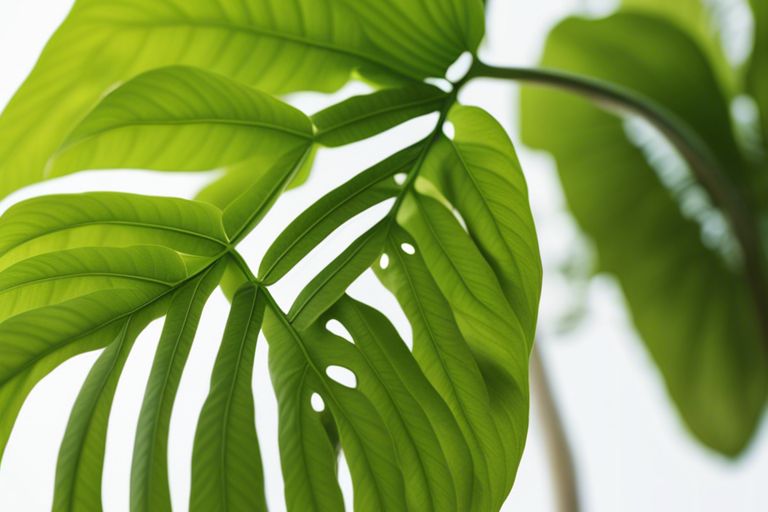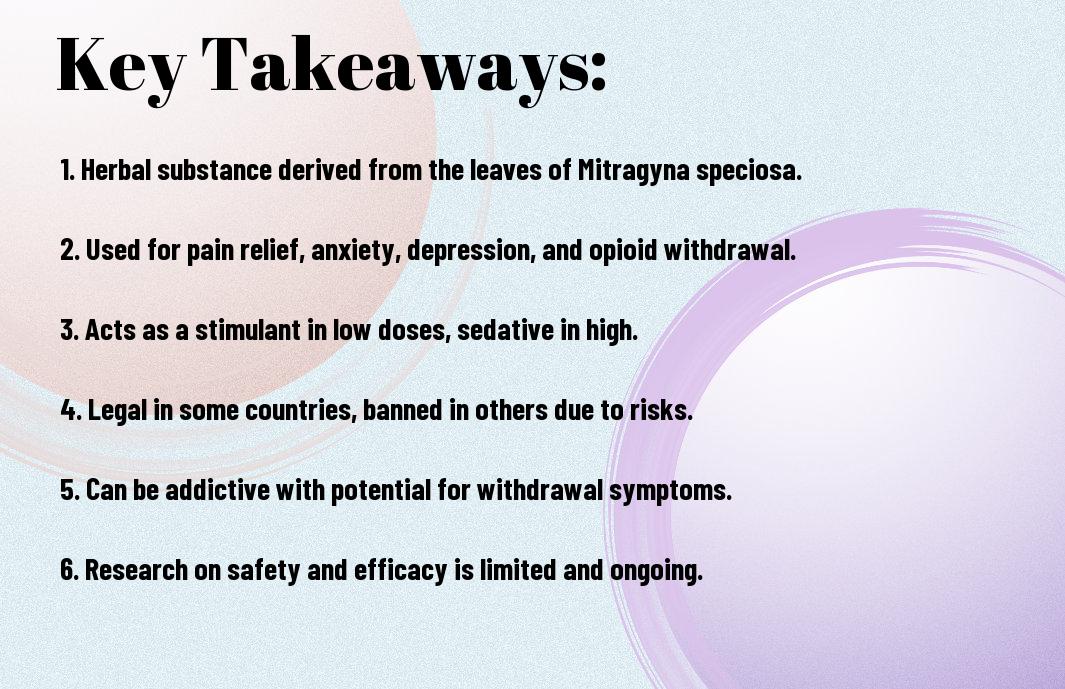Facts: Kratom, a tropical tree native to Southeast Asia, has gained popularity in the Western world for its potential medicinal and recreational uses. This plant, classified as a member of the coffee family, contains compounds that can have psychoactive effects. However, its legality and safety have been subjects of debate due to potential risks such as addiction and withdrawal symptoms. Understanding kratom and its properties is imperative for anyone considering its use.

Key Takeaways:
- Kratom is a tropical tree native to Southeast Asia. Its leaves contain compounds that have psychotropic (mind-altering) effects.
- Kratom is used for various purposes. It can act as a stimulant at low doses and a sedative at higher doses. Some people use it to manage chronic pain, anxiety, and depression.
- The use of kratom has raised concerns. While some people praise its benefits, there are risks of addiction, dependence, and adverse effects associated with its use. Regulations and research on kratom continue to evolve.

Origins and History
Southeast Asian Roots
Roots of kratom can be traced back to Southeast Asia, where the plant grows abundantly in countries like Thailand, Indonesia, Malaysia, and Papua New Guinea. The tropical climate and rich soil of these regions provide the perfect conditions for kratom trees to thrive. For centuries, kratom has been used by indigenous communities in Southeast Asia for its various medicinal and recreational properties.
Traditional Uses and Cultural Significance
Any discussion of kratom is incomplete without acknowledging its deep-rooted cultural significance in Southeast Asia. In countries like Thailand, kratom has been traditionally consumed by laborers and farmers to combat fatigue, increase productivity, and alleviate discomfort. Additionally, kratom has played a significant role in cultural rituals and ceremonies, where it is seen as a symbol of hospitality and respect.
Southeast Asian cultures have a long history of incorporating kratom into their daily lives, with various customs and beliefs surrounding its usage. The leaves of the kratom tree are often chewed or brewed into tea to reap its stimulating or sedative effects, depending on the dosage.
Chemical Composition
Alkaloids and Their Effects
Any discussion about kratom’s chemical composition must include a focus on its alkaloids. The primary alkaloids found in kratom leaves are mitragynine and 7-hydroxymitragynine. These alkaloids are responsible for the effects that users experience when consuming kratom.
Mitragynine and 7-Hydroxymitragynine: The Primary Actives
To examine deeper into the effects of kratom, one must understand the role of mitragynine and 7-hydroxymitragynine. Their interaction with receptors in the brain leads to pain relief, enhanced mood, and increased energy levels. These alkaloids are also responsible for the sedative effects that can occur at higher doses.
Alkaloids like mitragynine and 7-hydroxymitragynine are what make kratom a unique and complex botanical substance. Understanding their properties and effects is crucial for those interested in using kratom for its various potential benefits.
Pharmacological Effects
Opioid-Like Properties
Many studies have shown that kratom has opioid-like properties, as its active compounds interact with opioid receptors in the brain. One of the main alkaloids in kratom, mitragynine, binds to mu-opioid receptors, producing pain relief and euphoria similar to traditional opioids but with less risk of respiratory depression.
Stimulant-Like Properties
Properties. Kratom also exhibits stimulant-like effects at lower doses, with users reporting increased energy, alertness, and sociability. This stimulating effect is believed to be caused by mitragynine’s interaction with adrenergic receptors in the brain.
Analgesic and Anti-Inflammatory Effects
To
Many individuals who consume kratom do so for its analgesic and anti-inflammatory effects. The plant has been used traditionally in Southeast Asia to manage pain and inflammation. Anti-inflammatory research suggests that kratom may help reduce inflammation and pain by acting on inflammatory pathways in the body, providing relief for conditions such as arthritis and migraines.
Therapeutic Applications
Pain Management and Relief
Pain management and relief are some of the most common reasons people turn to kratom. Many users claim that kratom’s active compounds help alleviate various types of pain, from chronic conditions like arthritis to acute injuries. By interacting with opioid receptors in the brain, kratom can provide relief similar to traditional painkillers but without the risk of respiratory depression that often accompanies opioid medications.
Opiate Withdrawal and Addiction Treatment
Treatment for opiate withdrawal and addiction is another area where kratom has gained attention. For individuals struggling with substance abuse, kratom’s ability to interact with opioid receptors can help manage withdrawal symptoms and reduce cravings. Some users have successfully used kratom as a stepping stone towards sobriety, gradually reducing their dependence on stronger opiates.
Plus, unlike traditional addiction treatments that may come with their own set of side effects, kratom is considered a more natural alternative that many believe to be a gentler option for overcoming opiate addiction.
Anxiety and Depression Management
One of the lesser-known therapeutic applications of kratom is in managing symptoms of anxiety and depression. The mood-lifting and calming effects of certain kratom strains can help alleviate feelings of stress and sadness. While more research is needed to fully understand kratom’s impact on mental health, some users report that it has been a helpful tool in their mental health regimen.
Management of anxiety and depression is crucial for overall well-being, and the potential of kratom to aid in mood regulation is an area that continues to be explored by researchers and users alike.
Risks and Side Effects
Dependence and Withdrawal Symptoms
One potential risk of using kratom is the development of dependence and withdrawal symptoms. Regular use of kratom can lead to physical and psychological dependence, making it challenging for individuals to stop using the substance without experiencing withdrawal symptoms such as muscle aches, insomnia, irritability, and cravings.
Interactions with Medications and Substances
With its increasing popularity, it is crucial to be aware of the potential interactions kratom may have with medications and other substances. Kratom can interact with medications such as antidepressants, sedatives, and opioids, leading to harmful effects or reducing the effectiveness of the medications.
It is necessary to consult with a healthcare provider before using kratom, especially if you are taking any medications, to avoid any potential adverse interactions or complications.
Potential for Abuse and Overdose
Risks associated with kratom use include the potential for abuse and overdose. Due to its opioid-like effects, kratom can be addictive, and individuals may develop a tolerance, requiring higher doses to achieve the desired effects. This can increase the risk of overdose, which can lead to serious health complications or even death.
Overdose on kratom can cause respiratory depression, seizures, coma, and even death. It is crucial to use kratom responsibly and be aware of the signs of overdose to seek immediate medical help if necessary.
Legal Status and Regulation
International Laws and Restrictions
Legal: Unlike some other substances, kratom has varying legal statuses in different countries. In countries like Thailand and Malaysia, where kratom originates, it is classified as a controlled substance. In contrast, countries like the United Kingdom and Canada allow the sale and consumption of kratom, though regulations may be in place to monitor its use.
US Federal and State Laws
Legal: In the United States, kratom is legal at the federal level. However, some states and cities have passed laws banning its sale and possession. The FDA has also raised concerns about the safety of kratom, leading some states to introduce legislation to regulate its use.
A recent study published in the Journal of Psychoactive Drugs found that between 2010 and 2018, there were 1,807 calls to poison control centers related to kratom exposure, indicating a growing concern over its potential risks.
Emerging Trends in Kratom Legislation
Emerging: As the popularity of kratom grows, lawmakers are faced with the challenge of regulating its use. Some states have implemented age restrictions on kratom, while others are considering requiring warning labels on products containing kratom. Additionally, there is ongoing debate about whether kratom should be classified as a controlled substance at the federal level.
Restrictions: While some advocates argue that kratom can offer benefits such as pain relief and mood enhancement, opponents warn of its potential for abuse and addiction. The debate over kratom regulation is likely to continue as more research is conducted on its effects and safety profile.
Conclusion
Drawing together the information gathered from this article on kratom, it is evident that this herbal supplement derived from the leaves of the Mitragyna speciosa tree has gained popularity for its potential medicinal properties. While it has been traditionally used in Southeast Asia for various purposes, including pain relief and mood enhancement, its increasing popularity in Western countries has raised concerns regarding its safety and potential for misuse. To learn more about the drug profile of kratom, you can visit the Kratom (Mitragyna speciosa) drug profile.
FAQ
Q: What is kratom?
A: Kratom is a tropical plant native to Southeast Asia, known scientifically as Mitragyna speciosa. It has been used for centuries for its medicinal and recreational properties.
Q: How is kratom consumed?
A: Kratom leaves can be chewed, brewed into tea, or ground into a powder and ingested. It is also available in capsule form for easy consumption.
Q: What are the effects of kratom?
A: Kratom has stimulating effects at low doses and sedative effects at higher doses. It can also act as a pain reliever and mood enhancer.
Q: Is kratom legal?
A: The legal status of kratom varies by country and region. In some places, it is legal for medicinal or recreational use, while in others it is banned due to safety concerns.
Q: Are there any risks associated with kratom use?
A: While kratom is considered relatively safe when used responsibly, excessive consumption can lead to dependency, addiction, and adverse side effects. It is important to use kratom in moderation and under the guidance of a healthcare professional.










